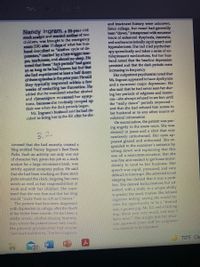
Ciccarelli: Psychology_5 (5th Edition)
5th Edition
ISBN: 9780134477961
Author: Saundra K. Ciccarelli, J. Noland White
Publisher: PEARSON
expand_more
expand_more
format_list_bulleted
Question
What type of disorder/s does she have?

Transcribed Image Text:**Article: Nancy Ingram's Mental Health Journey**
Nancy Ingram, a 33-year-old stock analyst and married mother of two children, experienced a severe mental health episode. Her husband described it as "another cycle of depression," marked by a short temper, tearfulness, and insomnia. These “dark periods” were not new, having occurred multiple times in the previous year, usually managed with fluoxetine. However, he noted an increase in severity and frequency. He also suspected alcohol and clonazepam might worsen her symptoms.
Recently, Nancy began an uncharacteristic activity: creating a blog titled "Nancy Ingram's Best Stock Picks." This was against company policy and consumed her time, ignoring personal responsibilities. Her husband decided to seek emergency help when this behavior surfaced.
Nancy’s mental health history includes depression since college, worsened by hereditary factors such as her father’s suicide and her grandmother’s breakdowns. Her past involved sporadic psychotherapy and antidepressant use, but her depressive baseline persisted.
According to her psychiatrist, Nancy showed signs of dysthymia and recurrent major depression, never seeking help during severe episodes. In the exam room, Nancy was agitated, untidy, with glazed eyes, and exhibited pressured speech. She admitted to poor sleep and displayed impaired judgment, claiming unique abilities like predicting the stock market. Her insight was poor, leading to concerns over her mental health stability and treatment adherence.
Expert Solution
This question has been solved!
Explore an expertly crafted, step-by-step solution for a thorough understanding of key concepts.
This is a popular solution
Trending nowThis is a popular solution!
Step by stepSolved in 3 steps

Knowledge Booster
Recommended textbooks for you
 Ciccarelli: Psychology_5 (5th Edition)PsychologyISBN:9780134477961Author:Saundra K. Ciccarelli, J. Noland WhitePublisher:PEARSON
Ciccarelli: Psychology_5 (5th Edition)PsychologyISBN:9780134477961Author:Saundra K. Ciccarelli, J. Noland WhitePublisher:PEARSON Cognitive PsychologyPsychologyISBN:9781337408271Author:Goldstein, E. Bruce.Publisher:Cengage Learning,
Cognitive PsychologyPsychologyISBN:9781337408271Author:Goldstein, E. Bruce.Publisher:Cengage Learning, Introduction to Psychology: Gateways to Mind and ...PsychologyISBN:9781337565691Author:Dennis Coon, John O. Mitterer, Tanya S. MartiniPublisher:Cengage Learning
Introduction to Psychology: Gateways to Mind and ...PsychologyISBN:9781337565691Author:Dennis Coon, John O. Mitterer, Tanya S. MartiniPublisher:Cengage Learning Psychology in Your Life (Second Edition)PsychologyISBN:9780393265156Author:Sarah Grison, Michael GazzanigaPublisher:W. W. Norton & Company
Psychology in Your Life (Second Edition)PsychologyISBN:9780393265156Author:Sarah Grison, Michael GazzanigaPublisher:W. W. Norton & Company Cognitive Psychology: Connecting Mind, Research a...PsychologyISBN:9781285763880Author:E. Bruce GoldsteinPublisher:Cengage Learning
Cognitive Psychology: Connecting Mind, Research a...PsychologyISBN:9781285763880Author:E. Bruce GoldsteinPublisher:Cengage Learning Theories of Personality (MindTap Course List)PsychologyISBN:9781305652958Author:Duane P. Schultz, Sydney Ellen SchultzPublisher:Cengage Learning
Theories of Personality (MindTap Course List)PsychologyISBN:9781305652958Author:Duane P. Schultz, Sydney Ellen SchultzPublisher:Cengage Learning

Ciccarelli: Psychology_5 (5th Edition)
Psychology
ISBN:9780134477961
Author:Saundra K. Ciccarelli, J. Noland White
Publisher:PEARSON

Cognitive Psychology
Psychology
ISBN:9781337408271
Author:Goldstein, E. Bruce.
Publisher:Cengage Learning,

Introduction to Psychology: Gateways to Mind and ...
Psychology
ISBN:9781337565691
Author:Dennis Coon, John O. Mitterer, Tanya S. Martini
Publisher:Cengage Learning

Psychology in Your Life (Second Edition)
Psychology
ISBN:9780393265156
Author:Sarah Grison, Michael Gazzaniga
Publisher:W. W. Norton & Company

Cognitive Psychology: Connecting Mind, Research a...
Psychology
ISBN:9781285763880
Author:E. Bruce Goldstein
Publisher:Cengage Learning

Theories of Personality (MindTap Course List)
Psychology
ISBN:9781305652958
Author:Duane P. Schultz, Sydney Ellen Schultz
Publisher:Cengage Learning